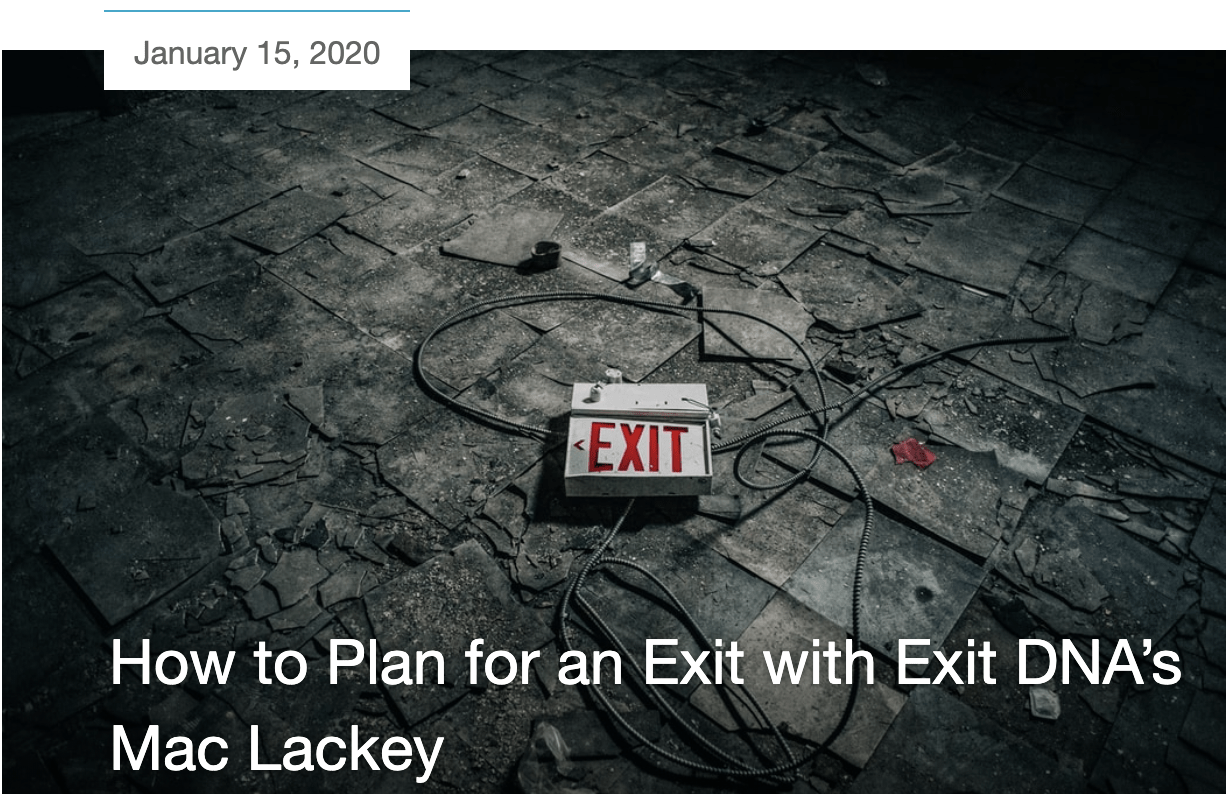
The following post is an excerpt from my conversation with Sujan Patel and a link to the full post and videos can be found on his site (links below)….
SUJAN: I’m passionate about sharing everything I know on SaaS business, so it’s not a huge surprise that I often hear the question, “How do I sell my company?”
The answer? I believe that you don’t just decide to sell, and then make it happen. The most successful people I know make a conscious decision regarding the kind of exit they want to have, and then they follow a carefully designed plan to make it happen.
That’s why I was so excited to sit down recently with Mac Lackey, founder of Exit DNA. Mac is a career entrepreneur who’s started, scaled, and exited six companies over the past 25 years, and who’s acted as a mentor, advisor, and investor in many others.
Mac and I met recently at Baby Bathwater in Croatia, and he was generous enough to sit down for a series of interviews with me on planning proactively for an exit.
Preparing Your Company to Be Sold
One of Mac’s best pieces of advice to come out of our conversation is that, “Companies are not bought. Companies are sold.” According to Mac, most entrepreneurs think they’re building something so valuable that an investor will eventually come pounding down their doors, offering to pay a premium for their companies. But that’s not something that happens very often.
Instead, Mac says, “As founders, we have to proactively design our companies so that they can be sold.” Fortunately, he continues, “there are a lot of simple things that you can do early in the process. If you decide you want to sell your company in a year or two, you can start adjusting and making changes now so that you can get a compounding effect that creates real value.”
Mac suggests having at least a 12-24 month horizon to make your company as valuable as possible. During that time, he recommends that founders ask themselves, “How would a buyer view this decision? What would a prospective buyer of my company think about this new hire, this new campaign, this new office, or this write off?”
I’m a big believer in this as well. At Ramp Ventures, all of our companies are built to be sold or operated to be sold – and since that’s our goal, we operate clean P&Ls. We aren’t writing off car payments or going out to fancy dinners. We’re making sure that every dollar we spend and every employee we hire is focused on maximizing our exit value.
Selling Based on Strategic Value, Not Financial Metrics
Since everyone wants to talk numbers when it comes to exit planning, I found Mac’s take on selling based on strategic value refreshing.
He explains, “One of the exercises I often take people through early in the process is an analysis that looks at their company through a pure financial lens. So, if you took some really common multiples of EBITDA and revenue, and you looked at those, the question is, ‘Would you sell your company for plus or minus 10% of that number?’ Most entrepreneurs immediately say, ‘Oh my gosh, I would never sell it for 5X EBITDA. That’s not a big enough number.’”
According to Mac, that friction means that founders need to focus on increasing the value – or the perceived value – of their companies through nonfinancial measures. He states, “I never once sold a company based on a financial multiple. It was always based on strategic value, and that’s where the premiums are. If you focus in on financial metrics and multiples, you’re leaving a lot of value on the table. As a founder, one of the things you can do is really turn up the volume on that strategic value.”
One way this happens comes from helping prospective buyers to envision your company as part of theirs. As Mac notes, “Now, you’re not really selling your business. You’re selling your business within their framework.” Mac gives the example of a company with a massive sales force that could easily multiply what you’re doing on a much smaller scale as a small team. “You’re starting to get them to see what’s possible. And when you sell what’s possible, the sky’s the limit.”
How to Identify Strategic Buyers
“In the marketplace, generally speaking,” he explains, “there are a couple of different categories of buyers for companies. The first category is a financial buyer. That’s what we typically think of as private equity firms, hedge funds, or someone that’s buying the business not because of its assets, but based on the financial performance of the business.”
By contrast, he notes, “The strategic buyer market is much broader. Strategic buyers can be anyone that identifies something in your organization that has strategic value to them. It could be intellectual property that you’ve created, trademarks, copyrights, or patents. It could be technology that you’ve built that’s unique. It could be your team. Or it could be a geography that you serve that this buyer is interested in moving into.”
Mac believes that founders have an obligation to create a market of strategic buyers for their companies. “What I tend to do is start with the path of least resistance,” he describes. “Whatever industry you’re in, a bigger version of your organization is a strategic buyer. If you’re a software company, there’s someone in the U.S or in the world that’s doing what you’re doing at a much bigger level. That’s a very easy example of a strategic buyer that is effectively a competitor.”
From there, Mac recommends expanding your search by degrees. “Let’s say you’re a SaaS company working with lawn care businesses. Then you would say, ‘All right, well there are other software as a service providers that are in the industry, but that are not specifically in lawn care.’ They’re in home. They’re in maintenance, or they’re in something a little bit broader. But maybe they don’t have a really strong offering in that little niche, so you broaden it out.”
He continues, “Then you go out another layer and say, ‘All right, well who is an organization that wants to have a relationship with a homeowner?’ And they may not have any offering in this category, but what their real driver is, is the relationship with the homeowner. You have to think about your company and what you potentially could offer to any type of buyer. What I end up doing is creating a spreadsheet with columns for different industries, and then below that I just start listing companies.”
Mac also creates Google alerts for the companies he identifies as part of this process in order to get updates on what they’re doing or talking about. He explains, “They will almost always tell you in their news stories, press releases, and podcast interviews. The CEO will be talking about their vision, their next product, their goals, and their ambitions. When you pick up the phone and call that CEO, not only are you a solution for that organization, you know exactly what the CEO has been telling the market he wants.”
To Mac, it’s all about the process. He recommends, “Even if it’s once a week in your calendar, have 20 or 30 minutes where you’re thinking about your universe of prospective buyers and your value proposition to them. It starts to become a roadmap to building value, because you start to identify gaps in the market that may be some of your big competitors aren’t addressing.”
Building Relationships with Strategic Buyers
As you’re forming these connections, Mac recommends identifying potential stakeholders at all levels. “Some people have all kinds of filters in front of them,” he notes. “So if it’s a CEO of a large company, they might have two or three roadblocks. You might not be able to get a face to face meeting quickly. If that’s the case, you’re looking for someone in strategic finance. You’re looking for someone in corporate development or business development that’s out in the market looking for opportunities.”
Far from being wasted effort, Mac explains that, “A lot of times, what ends up being an acquisition or a merger starts out as a joint venture, a distribution, or a partnership. So if you’re reaching out at a lower level, you can talk about how your organization can take theirs to another level. That’s of interest to someone in sales or corporate development. The more you navigate that process, sometimes it becomes apparent that you have an opportunity to sell your business.”
One final tip Mac offers is to be active within your industry. “Every industry has trade shows and events that prospective buyers – hopefully at the highest level, if not their key lieutenants – attend. Your ability to be present and visible at these events is a great strategy for building relationships with strategic buyers.”
———
If YOU are interested in optimizing your company, creating the OPTION to exit and at maximum value, but sure to get your FREE Exit Readiness Score and and more free exit advice via: maclackey.com/exit
This article was originally published by Sujan Patel. Sujan is a very talented entrepreneur, mentor, advisor, investor and all around great guy. If you’d like to connect with Sujan be sure to visit his site at: https://sujanpatel.com/




